PR-6171IRE Science A STEM Approach - 1st Class
Create successful ePaper yourself
Turn your PDF publications into a flip-book with our unique Google optimized e-Paper software.
Materials<br />
IT’S A STRETCH<br />
Lesson 3<br />
Teacher Notes<br />
Introduction:<br />
1. Recall what was learnt about playdough and how it can change shape. In pairs, pupils use a mini<br />
whiteboard to list words describing playdough, as discovered in the previous lesson. Pupils then<br />
share with the whole class.<br />
Development:<br />
2. Display a ball of playdough and a piece of chocolate at the front of the classroom. Using think-pairshare,<br />
pupils think about what would happen if the playdough and chocolate were placed in a hot<br />
oven. Individually, pupils use page 108 to write their prediction.<br />
3. In pairs, pupils then conduct the experiment on page 108. Ensure pupils do not touch anything hot<br />
and remind them about using equipment safely. Pupils can set a timer using an electronic timer or<br />
stopwatch.<br />
4. Once the playdough balls are cool to touch, and pupils have made their observations of the<br />
chocolate and playdough, they thread the playdough balls through a piece of string to create a<br />
necklace or bangle, which can later be decorated.<br />
Differentiation<br />
• Guided group work or individual support should be provided to ensure that all pupils have the<br />
opportunity to predict, observe and describe the changes to the playdough and chocolate.<br />
• Challenge: Provide children with names of other materials and ask them to predict what would<br />
happen to them if they were placed in a hot oven for ten minutes.<br />
Reflection:<br />
5. Pupils share their results for the warming and cooling part of the experiment and discuss how the<br />
playdough changed when it was heated compared to how the chocolate changed. What shape was<br />
it? What shape is it now? What happened to the hole? Could you twist the playdough? Squash it?<br />
Can you make it go back to how it was before? Can you make the chocolate go back to its original<br />
shape? How?<br />
6. In pairs, pupils construct a Venn diagram comparing the playdough and chocolate after it has been<br />
heated. Pupils can draw their own diagram based on the previous lesson (using the Venn diagram<br />
on the working wall), or use the template on page 109. Essentially, pupils should be able to state<br />
that playdough became hard and stayed in its ball shape, but the chocolate melted and changed<br />
shape. The hole stayed in the playdough, whereas in the chocolate the hole melted over.<br />
Viewing sample<br />
Prim-Ed Publishing – www.prim-ed.com 978-1-912760-15-2 <strong>1st</strong> <strong>Science</strong>: 107<br />
CLASS<br />
A <strong>STEM</strong> AP<strong>PR</strong>OACH

















